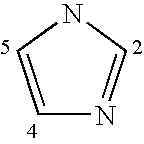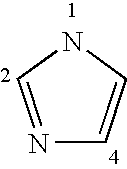Compounds, methods and formulations for the oral delivery of a glucagon-like peptide (GLP)-1 compound or a melanocortin-4 receptor (MC4) agonist peptide
a technology of glucagon-like peptides and oral delivery methods, which is applied in the direction of peptide/protein ingredients, drug compositions, metabolic disorders, etc., can solve the problems of ineffectiveness of agents, inability to effectively deliver active agents, and inability to rapidly render agents ineffective or destroyed in the gastrointestinal tra
- Summary
- Abstract
- Description
- Claims
- Application Information
AI Technical Summary
Benefits of technology
Problems solved by technology
Method used
Image
Examples
preparation 1
Octanedioic Acid Methyl Ester 2-Oxo-2-phenylethyl Ester
[0086]
[0087]Add a solution of sodium bicarbonate (2.12 g, 25.2 mmol) in water (10 mL) to a solution of suberic acid monomethyl ester (4.75 g, 25.2 mmol) in methanol (50 mL) at room temperature and stir the mixture for 30 minutes. Remove the solvent under reduced pressure and add the residue to a solution of 2-bromoacetophenone (5.0 g, 25.1 mmol) in acetone (150 mL) at room temperature under nitrogen. Heat the mixture at reflux for 10 hours and then remove the solvent under reduced pressure. Dilute the residue with diethyl ether (300 mL), stir for 20 minutes, filter through a short silica gel column, and wash with diethyl ether (2×50 mL). Remove the solvent under reduced pressure to provide octanedioic acid methyl ester 2-oxo-2-phenylethyl ester (6.9 g, 90%).
example 1
7-(4-Phenyloxazol-2-yl)heptanoic Acid Methyl Ester
[0088]
[0089]Heat a mixture of octanedioic acid methyl ester 2-oxo-2-phenylethyl ester (6.93 g, 22.6 mmol), acetamide (6.75 g, 114 mmol) and boron trifluoride diethyl etherate (3.0 mL, 23.7 mmol) at 135-140° C. under nitrogen for 4 hours. Cool the mixture, dilute with saturated NaHCO3 solution (100 mL), and extract with ethyl acetate (250 mL). Wash the organic extract with 100 mL of saturated aqueous sodium chloride (brine) and dry over sodium sulfate. Remove the solvent under reduced pressure and purify the residue by flash column chromatography on silica gel, eluting with hexanes / ethyl acetate (85:15), to provide 7-(4-phenyloxazol-2-yl)heptanoic acid methyl ester (5.7 g, 88%).
example 2
7-(4-Phenyloxazol-2-yl)heptanoic Acid
[0090]Add solution of sodium hydroxide (1.60 g, 40.0 mmol) in water (30 mL) to a solution of 7-(4-phenyloxazol-2-yl)heptanoic acid methyl ester (5.75 g, 20.0 mmol) in methanol (40 mL) at room temperature and heat the mixture at 40° C. for 2 hours. Adjust the pH of the mixture to 2 with 1 N HCl and extract with ethyl acetate (600 mL). Wash the organic extract with water (3×150 mL), dry over sodium sulfate and remove the solvent under reduced pressure. Triturate the residue with hexanes / ethyl acetate and collect the solids by filtration to provide 7-(4-phenyloxazol-2-yl)heptanoic acid (5.01 g, 91%): APCI mass spectrum m / z 272 [C16H19NO3−H]−.
[0091]Prepare Examples 3-30, compounds of formula II(a) listed in Table 1 below, by the same process as in the preparation of Example 2.
[0092]
TABLE 1Compounds of formula II(a)II(a)Exam-R1 (positionR2 (position onpleon ring)ring)nmass spectrum m / z3OCH3 (1)H3261 [C14H15NO4]+4OCH3 (1)H4276 [C15H17NO4 + H]+5OCH3 (1)...
PUM
| Property | Measurement | Unit |
|---|---|---|
| pressure | aaaaa | aaaaa |
| flow rate | aaaaa | aaaaa |
| temperature | aaaaa | aaaaa |
Abstract
Description
Claims
Application Information
 Login to View More
Login to View More - R&D
- Intellectual Property
- Life Sciences
- Materials
- Tech Scout
- Unparalleled Data Quality
- Higher Quality Content
- 60% Fewer Hallucinations
Browse by: Latest US Patents, China's latest patents, Technical Efficacy Thesaurus, Application Domain, Technology Topic, Popular Technical Reports.
© 2025 PatSnap. All rights reserved.Legal|Privacy policy|Modern Slavery Act Transparency Statement|Sitemap|About US| Contact US: help@patsnap.com



